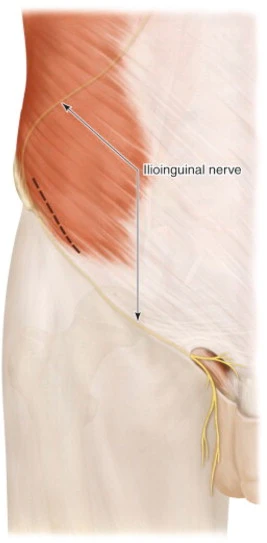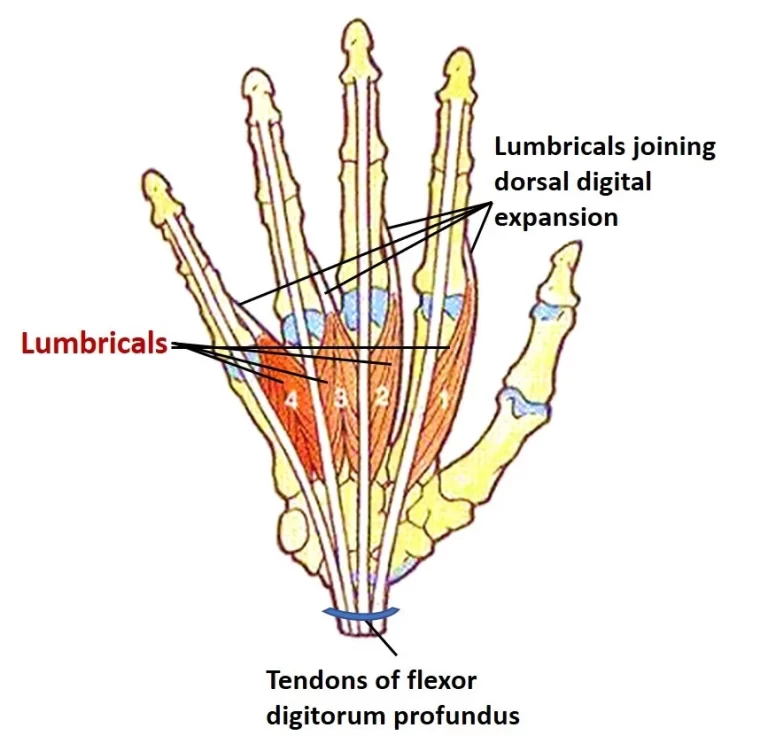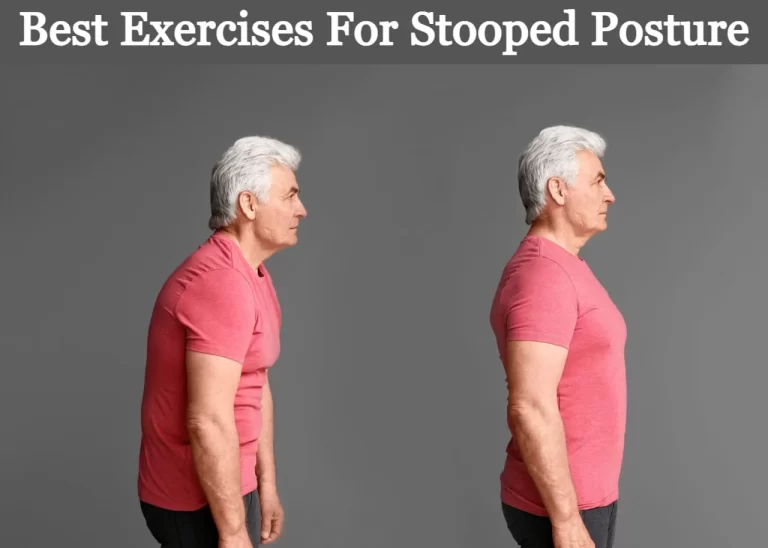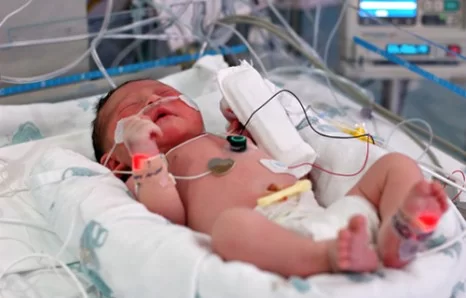Medial Collateral Ligament
Introduction
The MCL, or medial collateral ligament, is a ligament located on the inside of the knee joint. It connects the femur (thigh bone) to the tibia (shin bone) and helps to stabilize the knee during movements such as walking, running, and jumping. The MCL is one of four major ligaments in the knee, along with the anterior cruciate ligament (ACL), posterior cruciate ligament (PCL), and lateral collateral ligament (LCL).
Injuries to the MCL can occur due to direct trauma or sudden twisting movements and can range from mild sprains to complete tears. Treatment for MCL injuries typically involves rest, ice, compression, and physical therapy, although more severe cases may require surgery.
Structure of the medial collateral ligament
The MCL is a strong, fibrous band of tissue that runs along the inside of the knee joint. It is composed of several layers of collagen fibers that are arranged in a crisscross pattern, providing both strength and flexibility to the ligament.
At its upper end, the MCL attaches to the medial epicondyle of the femur, a bony protrusion on the inner side of the thigh bone. From there, it extends downward and attaches to the tibia, just below the joint line. The lower end of the MCL also attaches to a small bone in the ankle called the medial malleolus.
The MCL is divided into two main parts: the superficial and deep layers. The superficial layer is located on the outer surface of the ligament and is responsible for resisting forces that push the knee inward (valgus stress). The deep layer, on the other hand, is located on the inner surface of the ligament and is responsible for resisting forces that twist or rotate the knee.
moreover, it is the primary function of stabilizing the knee joint, the MCL also plays a role in maintaining proper alignment and tracking of the patella (kneecap). It also helps to distribute weight and forces across the knee joint during weight-bearing activities.
Overall, the structure of the MCL is crucial for maintaining stability and function of the knee joint, and injuries to this ligament can have significant implications for an individual’s ability to do daily activities and take part in sports or other physical activities.
Purpose of the medial collateral ligament
The main purpose of the MCL is to provide stability to the knee joint, particularly in side-to-side movements.
The MCL acts as a primary restraint against forces that push the knee outward, such as those that might occur during a tackle in football or a collision while skiing. It also helps to prevent excessive inward movement of the knee, which could cause damage to the joint surfaces and other structures within the knee.
Moreover, to this it provides stability, the MCL also plays a role in shock absorption, helping to distribute forces throughout the knee joint during weight-bearing activities like walking, running, and jumping.
Like other ligaments in the knee, the MCL can be injured due to sudden trauma or overuse. Symptoms of an MCL injury may include pain, swelling, stiffness, and difficulty bending or straightening the knee. In more severe cases, the knee may feel unstable or give way during activity.
Overall, the MCL is an important structure in the knee joint that helps to maintain stability and function during a variety of activities. Understanding its role and how to prevent and manage injuries can help individuals maintain mobility and quality of life.
Blood supply of the medial collateral ligament
The blood supply of the MCL is important for its healing and recovery after injury. The MCL receives its blood supply from several sources, including the medial superior genicular artery, the medial inferior genicular artery, and the descending genicular artery.
The medial superior genicular artery originates from the popliteal artery and provides blood supply to the upper portion of the MCL. The medial inferior genicular artery also originates from the popliteal artery and supplies blood to the lower portion of the MCL. The descending genicular artery, which originates from the femoral artery, provides additional blood supply to the MCL.
In addition to these arteries, the MCL also receives blood supply from small vessels that penetrate its surface. These vessels help to nourish the ligament and promote healing after injury.
When an MCL injury occurs, the blood supply to the ligament may be disrupted, which can slow down the healing process. Therefore, it is important to take steps to promote blood flow to the injured area, such as through physical therapy exercises and other forms of rehabilitation.
In the end, we can say, understanding the blood supply of the MCL is important for managing injuries and promoting the healing of this important structure in the knee joint.
Symptoms of the medial collateral ligament
Symptoms of an MCL injury can differ depending on the severity of the injury. Some common symptoms include:
- Knee Pain: Pain is typically felt on the inside of the knee and may be sharp or dull, depending on the severity of the injury.
- Swelling: Swelling may occur immediately after the injury or develop over time. The knee may experience stiffness and difficulty moving.
- Instability: The knee may feel unstable or give way when weight is placed on it. This can make it difficult to walk or participate in physical activity.
- Bruising: Bruising may occur around the knee and may spread down the leg.
- Limited range of motion: The knee may feel stiff and difficult to move, making it difficult to fully extend or bend the knee.
- Tenderness: The area around the MCL may be tender to the touch.
- Popping or clicking: In some cases, a popping or clicking sensation may be felt at the time of the injury.
It is very crucial to take medical attention if any of these symptoms occur after an injury to the knee. An accurate diagnosis and appropriate treatment can help to promote healing and prevent further damage.
Injuries of the medial collateral ligament
The MCL can be injured in a variety of ways, including:
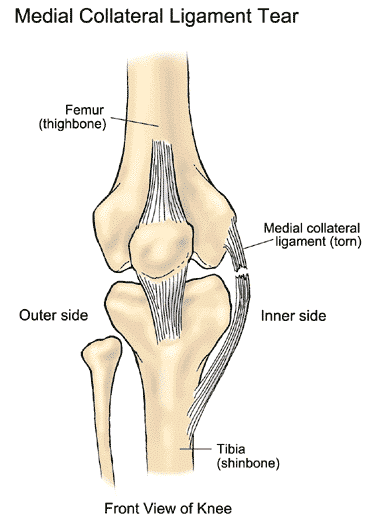
- Direct impact: A direct blow to the outside of the knee can cause the MCL to stretch or tear.
- Twisting motion: Sudden twisting or pivoting movements can cause the knee to rotate inward, putting stress on the MCL and potentially causing it to tear.
- Hyperextension: When the knee is forced beyond its normal range of motion, such as during a fall or landing from a jump, the MCL may be stretched or torn.
- Overuse: Repetitive stress on the MCL, such as from running or jumping, can lead to inflammation and eventually injury.
- Improper landing technique: Poor technique when landing from a jump or changing direction can put excessive stress on the MCL and increase the risk of injury.
- Sports-related injuries: Contact sports such as football, soccer, and basketball carry a higher risk of MCL injuries due to the potential for collisions and sudden changes in direction.
- Car accidents: In some cases, MCL injuries can occur as a result of car accidents or other traumatic events that cause a sudden impact on the knee.
Treatment of the medial collateral ligament
Conservative treatment
Conservative treatment of MCL (Medial Collateral Ligament) injury involves non-surgical methods to promote healing and reduce pain and inflammation. The following are the steps involved in conservative treatment of MCL:
- Rest: Resting the injured knee is essential to promote healing. The patient should avoid any activities that cause pain or discomfort to the knee.
- Ice: Applying ice to the knee for 20-30 minutes, 3-4 times a day can help reduce pain and inflammation.
- Compression: Wearing a compression bandage or knee brace can be helpful in giving support to the knee and reducing swelling.
- Elevation: Elevating the injured knee above the heart level can help reduce swelling and promote blood flow to the area.
- Medications: Over-the-counter pain medications like ibuprofen or acetaminophen can be very useful for decreasing pain and inflammation.
- Physical therapy: Physical therapy exercises can help strengthen the muscles around the knee and promote healing of the MCL.
- Activity modification: Avoiding activities that put stress on the knee, such as running or jumping, can help prevent further injury and promote healing.
- Gradual return to activity: Once the knee has healed, gradually returning to normal activities can help prevent re-injury.
In the end, conservative treatment of MCL involves a combination of rest, ice, compression, elevation, medication, physical therapy, activity modification, and gradual return to activity. It is important to follow the treatment plan prescribed by a doctor for optimal healing and recovery.
Physiotherapy treatment
Physiotherapy treatment for MCL (Medial Collateral Ligament) injury involves a series of exercises and techniques to promote healing, reduce pain, and improve range of motion. The following are the steps involved in physiotherapy treatment for MCL:

- Assessment: The physiotherapist will assess the extent of the MCL injury and determine the appropriate treatment plan.
- Ice and compression: The physiotherapist may apply ice and compression to the knee to reduce pain and swelling before starting the exercises.
- Range of motion exercises: The physiotherapist will guide the patient through a series of exercises to improve the range of motion in the knee. These may include gentle stretches, passive range of motion exercises, and active range of motion exercises.
- Strengthening exercises: Once the range of motion has improved, the physiotherapist will guide the patient through a series of exercises to strengthen the muscles around the knee. These may include quadriceps strengthening exercises, hamstring strengthening exercises, and calf strengthening exercises.
- Balance and stability exercises: The physiotherapist may also include balance and stability exercises to improve the patient’s ability to bear weight on the injured knee.
- Proprioceptive training: This involves exercises that improve the patient’s ability to sense the position and movement of their knee joint. This can help prevent re-injury.
- Gait training: The physiotherapist may also work with the patient on their walking pattern to ensure proper alignment and reduce stress on the knee joint.
- Gradual return to activity: Once the knee has healed, the physiotherapist will guide the patient through a gradual return to normal activities. This may include sports-specific training to ensure that the patient is ready to return to their sport safely.
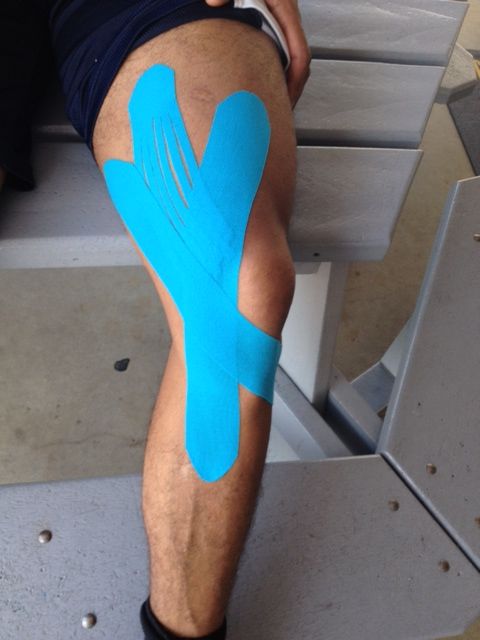
In the end, physiotherapy treatment for MCL involves a combination of various range of motion exercises, strengthening exercises, balance and stability exercises, proprioceptive training, gait training, and gradual return to activity. It is important to follow the treatment plan prescribed by a physiotherapist for optimal healing and recovery.
Risk factors of the medial collateral ligament
MCL injuries can occur due to a variety of reasons, including:
- Sports activities: MCL injuries are very common in sports like soccer, football, basketball, and skiing which require fast changes in direction.
- Direct impact: A direct blow to the outside of the knee can cause an MCL injury.
- Overuse: Repeated stress on the MCL due to activities such as running or jumping can lead to an MCL injury.
- Age: As we age, the ligaments in our body become less flexible and more prone to injury.
- Obesity: Being overweight puts extra stress on the knee joint, increasing the risk of MCL injury.
- Previous knee injuries: A previous knee injury, such as an ACL tear, can increase the risk of an MCL injury.
- Poor conditioning: Weak muscles around the knee joint can increase the risk of MCL injury.
- Improper technique: Using improper technique during sports or exercise can increase the risk of MCL injury.
It is very important to be aware of these risk factors and take appropriate precautions to prevent MCL injuries. This may include proper warm-up and stretching before exercise, using proper technique during sports activities, maintaining a healthy weight, and working with a physiotherapist to improve muscle strength and flexibility around the knee joint.
How to prevent the risk of injuries to the medial collateral ligament
Preventing MCL injuries involves taking several precautions to reduce the risk of injury. Here are some ways to prevent MCL injuries:
- Warm-up and stretching: Before any sports or exercise, it is essential to warm up and stretch properly. This helps to prepare the muscles, tendons, and ligaments for physical activity, reducing the risk of injury.
- Use proper technique: MCL injuries are very common in sports like soccer, football, basketball, and skiing which require fast changes in direction. For example, in sports that involve sudden changes in direction, such as football or basketball, it is important to pivot on the balls of your feet rather than twisting your knee.
- Wear appropriate gear: Wearing appropriate gear such as knee pads, braces, or supportive shoes can help reduce the risk of MCL injuries.
- Maintain a healthy weight: Being overweight puts extra stress on the knee joint, increasing the risk of MCL injury. Maintaining a healthy weight can be very helpful in reducing this risk.
- Strengthen muscles around the knee joint: Weak muscles around the knee joint can increase the risk of MCL injury. Working with a physiotherapist to improve muscle strength and flexibility around the knee joint can help reduce this risk.
- Avoid overuse: Repeated stress on the MCL due to activities such as running or jumping can lead to an MCL injury. It is important to avoid overuse and give your body time to rest and recover.
- Be cautious when returning from an injury: If you have had a previous knee injury, such as an ACL tear, it is important to be cautious when returning to sports or exercise. Working with a physiotherapist to develop a safe and gradual return-to-activity plan can help reduce the risk of further injury.
In conclusion, we can say to preventing MCL injuries involves taking appropriate precautions such as warming up, using proper technique, wearing appropriate gear, maintaining a healthy weight, strengthening muscles around the knee joint, avoiding overuse, and being cautious when returning from an injury. By following these guidelines, you can help reduce the risk of MCL injuries and keep your knees healthy and strong.
Summary
The MCL, or medial collateral ligament, is a ligament located on the inner side of the knee. It gives the knee joint stability and aids in limiting the knee’s excessive inward movement. MCL injuries can occur due to sudden twisting or bending of the knee, direct impact on the knee, or overuse injuries. Symptoms of an MCL injury may include pain, swelling, and difficulty moving the knee. Treatment for MCL injuries may involve rest, ice, compression, elevation, physical therapy, and in some cases, surgery. Recovery time for an MCL injury can vary depending on the severity of the injury and the treatment approach used.
FAQ
What is the MCL?
The MCL (medial collateral ligament) is a ligament in the knee that connects the thigh bone to the shin bone on the inner side of the knee.
How do MCL injuries occur?
MCL injuries can occur due to sudden twisting or impact to the knee, such as during sports or physical activity.
What is the characteristic of an MCL injury?
Symptoms of an MCL injury may include pain, swelling, stiffness, and difficulty bearing weight on the affected leg.
How are MCL injuries treated?
MCL injuries are typically treated with rest, ice, compression, and elevation (RICE), as well as physical therapy and/or bracing. In extreme cases, surgery can be required.
How long time does it take to recover from an MCL injury?
The recovery time for an MCL injury can differ depending on the effect of the injury. Mild injuries may heal within some weeks, while more severe injuries may take several months to fully heal.

